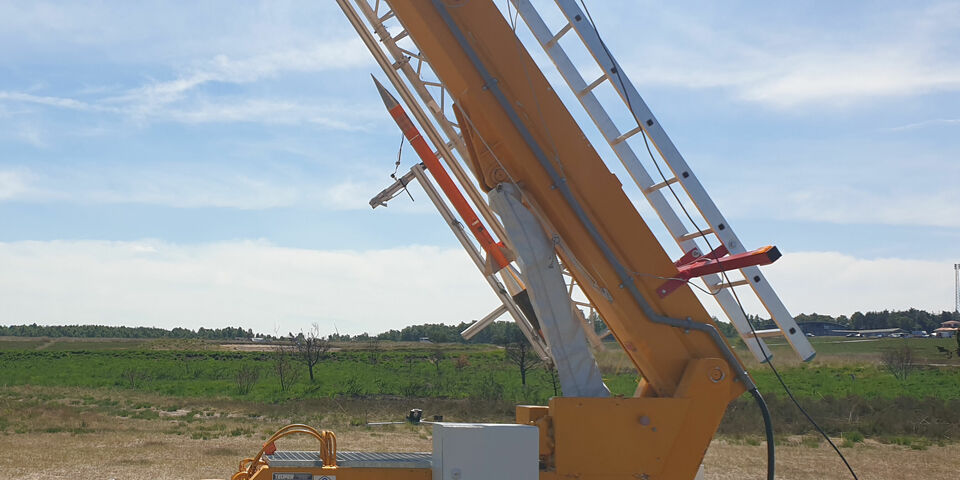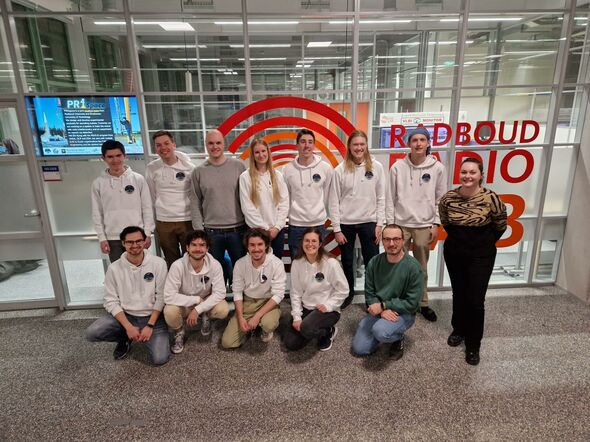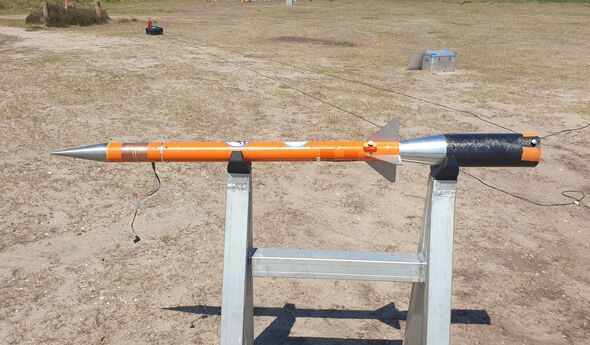How do you make a test rocket-proof?
Student team PR4 Space is preparing two test setups that will travel onboard a rocket next year. The team, a collaboration between TU/e and Radboud University, takes part in the European Space Agency’s REXUS project, which is why it is allowed to use part of the rocket for two experiments. “The aim is for the REXUS rocket to reach an altitude of 80 kilometers above the earth’s surface,” team members and master’s students at Electrical Engineering Benno Driessen and Reinier Seuren say.
What does the name PR4 Space mean? “It stands for Payload for Radio-interferometry and Radiations measurement on Rockets Revisited.” Revisited? “We are the successor of the PR3 Space team, which designed an experiment on board of a previous REXUS rocket.” Team members Benno Driessen (28) and Reinier Seuren (23) pursue a master’s degree in Embedded Systems and Electrical Engineering respectively, and focus on a subject related to PR4 Space for their graduation.
The team consists of twenty students, five of whom study at TU/e. The others study at Radboud University Nijmegen. “We complement each other: they focus on theory, algorithms and data processing. Our focus is on engineering, working on the hardware.” PR4 Space is supported by the Radiolab in Nijmegen and has access to its laboratory space. “And there are several lecturers in Eindhoven, such as Roel Jordans, who are glad to share their thoughts with us.”
Kiruna
REXUS/BEXUS is a program by European Space Agency ESA that launches rockets and balloons on a regular basis, carrying experiments designed by students. In March 2024, REXUS 31 and 32 are scheduled to launch. REXUS 31 will carry an experiment by PR4 Space. The rocket will launch from the town of Kiruna, in northern Sweden.
“The rocket has a diameter of 36 centimeters and is approximately 5.6 meters long. Part of the rocket is divided into small ‘slices’ that can be used for experiments,” Seuren explains. “Our segment is 12 centimeters high.” Apart from the tests from Eindhoven/Nijmegen, the rocket will also carry experiments from Delft, Germany and Greece.
Ceramic
It’s possible for PR4 Space to send not one but two test setups, because one of the test setups is for the most part mounted on the outside of the rocket. This experiment is about location tracking with radio-interferometry. Seuren explains what that is.
“We’ve mounted antennas on the outside of the rocket, in the shape of small, bended plates. The radio signals they transmit are received by ground stations, some of which are located several hundred meters removed from the starting point, and others at several kilometers. Using triangulation, we then estimate the rocket’s location during different moments of its journey as accurately as we can.”
Determining the exact location is important for all kinds of research, Driessen adds. “If you can map data, it becomes easier to interpret it.” And knowing a rocket’s exact location is important for security reasons as well.
“A spacecraft that deviates from its orbital course around earth can create a dangerous situation. That is why its location needs to be constantly monitored in two ways. Now, a radar and sensors attached to the rocket are used to monitor its position. In the future, radio-interferometry could become a substitute, or a supplementary method.”
What’s the difference between the PR4 experiment and the PR3 experiment, which took place in 2019? Seuren, who studies this subject for his graduation, explains: “The material for the antennas – two layers of copper and a ceramic layer, made flexible with a special coating – is much thinner now. That makes it easier to mount the antennas onto the outside of the rocket module.”
Stress test
The second experiment is about ray detection: detecting solar radiation, for example. “Eventually, this could become very useful for predicting the weather: radiation influences cloud formation, and consequently, weather conditions,” Driessen says. The team uses a so-called scintillator to measure radiation. “The material, a luminescent synthetic material, was given to us by CERN.”
The team stacked eight plates of this material, leaving some room in between. The number of plates that light up as a radiation particle – which moves straight through the rocket’s aluminium and sensors – passes through, gives an indication of the direction from which the particle came. Seuren: “The major challenge is to make sure that the system continues to measure at all times: the pulses of light are very short, since radiation particles almost move with the speed of light.”
And there’s a second challenge: making sure that the test setup is space-proof. That is the focus of Driessen’s graduation project. “The main question is: how do you design electronics for space? That isn’t simple. To illustrate: 42 percent of small satellites launched between 2008 and 2016 didn’t function properly.”
Conditions are harsh: the launch of a rocket generates large vibrations, the outside temperature can run up to 200 degrees Celsius, and the vacuum in space also has an influence. How do you ensure that all those chips, cables and soldered connections can withstand space travel? “We can expose the setup to stress tests with the values provided by ESA.”
Soft landing
Until REXUS 31 goes into space a year from now, the team gets a ‘free ride’ now and then on smaller rockets made by the company T-Minus, and – whenever possible – by Dare, the student team from Delft. “We recently witnessed the launch of a rocket by T-Minus on military base ‘t Harde near Zwolle. That rocket is almost a meter and half long and reached an altitude of one and a half kilometers, because it was launched from an angle. When it descends it hits the ground and is gone – also because the terrain is littered with unexploded munition.”
The T-Minus rocket can reach a maximum speed of five times the speed of sound. The REXUS is a bit slower, but it will be launched vertically, with the aim of reaching an altitude of 80 kilometres. Thanks to a parachute and the Swedish snow, the rocket will have a soft landing, so that the student teams can collect their data.
Postponed
The launch of REXUS 31 was supposed to take place a long time ago, but it was postponed several times due to Covid-19 and the war in Ukraine. At the time of the launch, in March of next year, Driessen and Seuren will have already graduated.
In the meantime, the team has shifted its focus to a next adventure, Driessen says. “We submitted a research proposal for the analog Mars mission AMADEE-24 from the Austrian space organization. We will use our PR4 system to localize and trace astronauts.” An analog mission is an exact simulation of a space flight, only on earth – in the desert of Israel, to be precise.




Discussion